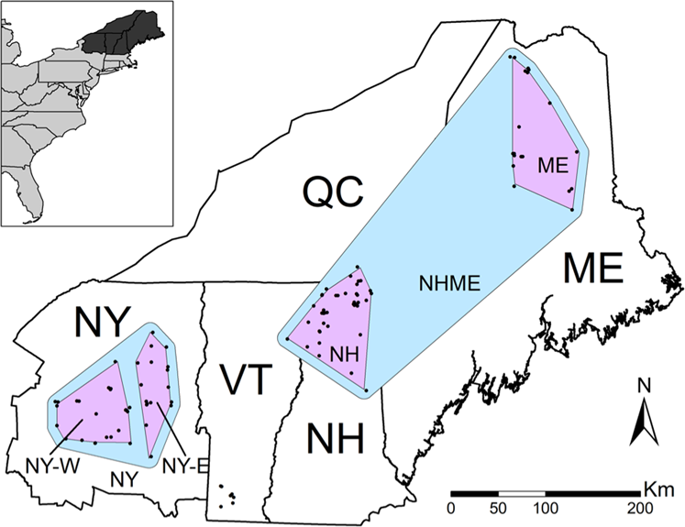Our official English website, www.x-mol.net, welcomes your
feedback! (Note: you will need to create a separate account there.)
Multiscale landscape genetics of American marten at their southern range periphery
Heredity ( IF 3.1 ) Pub Date : 2020-01-28 , DOI: 10.1038/s41437-020-0295-y Cody M Aylward 1, 2, 3 , James D Murdoch 1 , C William Kilpatrick 4
Heredity ( IF 3.1 ) Pub Date : 2020-01-28 , DOI: 10.1038/s41437-020-0295-y Cody M Aylward 1, 2, 3 , James D Murdoch 1 , C William Kilpatrick 4
Affiliation

|
American marten (Martes americana) are a conservation priority in many forested regions of North America. Populations are fragmented at the southern edge of their distribution due to suboptimal habitat conditions. Facilitating gene flow may improve population resilience through genetic and demographic rescue. We used a multiscale approach to estimate the relationship between genetic connectivity and landscape characteristics among individuals at three scales in the northeastern United States: regional, subregional, and local. We integrated multiple modeling techniques and identified top models based on consensus. Top models were used to parameterize resistance surfaces at each scale, and circuit theory was used to identify potential movement corridors. Regional gene flow was affected by forest cover, elevation, developed land cover, and slope. At subregional and local scales, the effects were site specific and included subsets of temperature, elevation, developed land cover, and slope. Developed land cover significantly affected gene flow at each scale. At finer scales, lack of variance in forest cover may have limited the ability to detect a relationship with gene flow. The effect of slope on gene flow was positive or negative, depending on the site examined. Occupancy probability was a relatively poor predictor, and we caution its use as a proxy for landscape resistance. Our results underscore the importance of replication and multiscale approaches in landscape genetics. Climate warming and landscape conversion may reduce the genetic connectivity of marten populations in the northeastern United States, and represent the primary challenges to marten conservation at the southern periphery of their range.
中文翻译:

美国貂南缘边缘的多尺度景观遗传学
美洲貂 (Martes americana) 是北美许多森林地区的重点保护对象。由于次优的栖息地条件,种群在其分布的南部边缘分散。促进基因流动可以通过基因和人口拯救来提高人口的适应力。我们使用多尺度方法来估计美国东北部三个尺度的个体之间的遗传连通性和景观特征之间的关系:区域、次区域和地方。我们整合了多种建模技术,并根据共识确定了顶级模型。顶级模型用于参数化每个尺度的阻力表面,电路理论用于识别潜在的运动走廊。区域基因流受森林覆盖率、海拔、发达土地覆盖率和坡度的影响。在次区域和局部尺度上,影响是特定地点的,包括温度、海拔、开发的土地覆盖和坡度的子集。发达的土地覆盖对各个尺度的基因流都有显着影响。在更精细的尺度上,森林覆盖率缺乏变化可能限制了检测与基因流关系的能力。斜率对基因流的影响是积极的还是消极的,这取决于所检查的位点。占用概率是一个相对较差的预测指标,我们警告将其用作景观阻力的代理。我们的结果强调了景观遗传学中复制和多尺度方法的重要性。气候变暖和景观转变可能会降低美国东北部貂种群的遗传连通性,
更新日期:2020-01-28
中文翻译:

美国貂南缘边缘的多尺度景观遗传学
美洲貂 (Martes americana) 是北美许多森林地区的重点保护对象。由于次优的栖息地条件,种群在其分布的南部边缘分散。促进基因流动可以通过基因和人口拯救来提高人口的适应力。我们使用多尺度方法来估计美国东北部三个尺度的个体之间的遗传连通性和景观特征之间的关系:区域、次区域和地方。我们整合了多种建模技术,并根据共识确定了顶级模型。顶级模型用于参数化每个尺度的阻力表面,电路理论用于识别潜在的运动走廊。区域基因流受森林覆盖率、海拔、发达土地覆盖率和坡度的影响。在次区域和局部尺度上,影响是特定地点的,包括温度、海拔、开发的土地覆盖和坡度的子集。发达的土地覆盖对各个尺度的基因流都有显着影响。在更精细的尺度上,森林覆盖率缺乏变化可能限制了检测与基因流关系的能力。斜率对基因流的影响是积极的还是消极的,这取决于所检查的位点。占用概率是一个相对较差的预测指标,我们警告将其用作景观阻力的代理。我们的结果强调了景观遗传学中复制和多尺度方法的重要性。气候变暖和景观转变可能会降低美国东北部貂种群的遗传连通性,











































 京公网安备 11010802027423号
京公网安备 11010802027423号